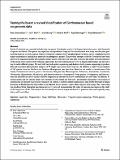Por favor, use este identificador para citar o enlazar a este item:
http://hdl.handle.net/10261/262169COMPARTIR / EXPORTAR:
 SHARE SHARE
 CORE
BASE CORE
BASE
|
|
| Visualizar otros formatos: MARC | Dublin Core | RDF | ORE | MODS | METS | DIDL | DATACITE | |

| Título: | Taming the beast: a revised classification of Cortinariaceae based on genomic data |
Autor: | Liimatainen, Karen; Kim, Jan T.; Pokorny, Lisa CSIC ORCID; Kirk, P.M.; Dentinger, B. T. M.; Niskanen, T. | Palabras clave: | Agaricales Fungariomics Fungi HybPiper Museomics Targeted capture sequencing Whole genome sequencing |
Fecha de publicación: | 23-feb-2022 | Editor: | Springer Nature | Citación: | Fungal Diversity 112: 89–170 (2022) | Resumen: | Family Cortinariaceae currently includes only one genus, Cortinarius, which is the largest Agaricales genus, with thousands of species worldwide. The species are important ectomycorrhizal fungi and form associations with many vascular plant genera from tropicals to arctic regions. Genus Cortinarius contains a lot of morphological variation, and its complexity has led many taxonomists to specialize in particular on infrageneric groups. The previous attempts to divide Cortinarius have been shown to be unnatural and the phylogenetic studies done to date have not been able to resolve the higher-level classifcation of the group above section level. Genomic approaches have revolutionized our view on fungal relationships and provide a way to tackle difcult groups. We used both targeted capture sequencing and shallow whole genome sequencing to produce data and to perform phylogenomic analyses of 75 single-copy genes from 19 species. In addition, a wider 5-locus analysis of 245 species, from the Northern and Southern Hemispheres, was also done. Based on our results, a classifcation of the family Cortinariaceae into ten genera—Cortinarius, Phlegmacium, Thaxterogaster, Calonarius, Aureonarius, Cystinarius, Volvanarius, Hygronarius, Mystinarius, and Austrocortinarius—is proposed. Seven genera, 10 subgenera, and four sections are described as new to science and fve subgenera are introduced as new combinations in a new rank. In addition, 41 section names and 514 species names are combined in new genera and four lecto- and epitypes designated. The position of Stephanopus in suborder Agaricineae remains to be studied. Targeted capture sequencing is used for the frst time in fungal taxonomy in Basidiomycetes. It provides a cost-efcient way to produce -omics data in species-rich groups. The -omics data was produced from fungarium specimens up to 21 years old, demonstrating the value of museum specimens in the study of the fungal tree of life. This study is the frst family revision in Agaricales based on genomics data and hopefully many others will soon follow. | Versión del editor: | http://dx.doi.org/10.1007/s13225-022-00499-9 | URI: | http://hdl.handle.net/10261/262169 | DOI: | 10.1007/s13225-022-00499-9 | Identificadores: | doi: 10.1007/s13225-022-00499-9 issn: 1560-2745 |
| Aparece en las colecciones: | (IBB) Artículos |
Ficheros en este ítem:
| Fichero | Descripción | Tamaño | Formato | |
|---|---|---|---|---|
| Liimatainenetal2022.pdf | 5,41 MB | Adobe PDF |  Visualizar/Abrir |
CORE Recommender
SCOPUSTM
Citations
34
checked on 21-abr-2024
WEB OF SCIENCETM
Citations
25
checked on 20-feb-2024
Page view(s)
184
checked on 23-abr-2024
Download(s)
239
checked on 23-abr-2024
Google ScholarTM
Check
Altmetric
Altmetric
Este item está licenciado bajo una Licencia Creative Commons

